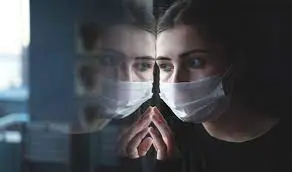Post-Traumatic Stress Disorder?
Post-Traumatic Stress Disorder

A person may suffer post-traumatic stress disorder after exposure to a shock, serious, or frightening event such as natural disasters, severe accidents, or life-threatening disease Etc.
This disturbance can occur if the person has been involved in an accident or if he/she is a witness to a terrible accident involving other people such as being a witness to a serious traffic accident.
Most people overcome these experiences over time even without psychological help, but this may cause a reaction in other people that lasts for months or years, which is called post-traumatic stress disorder.
What is post-traumatic stress disorder?
Post-traumatic stress disorder a psychiatric disorder that may begin after a collision can be a horrific or painful event in which serious bodily harm or threat is involved.
This disorder always results after traumatic events that cause terror, fear, and extreme disability such as physical or sexual assault, A Loved one unexpected death, war, accident, or natural disaster.
Common reactions from these people include nervous shock, fear, anger, and even guilt.
With Most people, the fear feeling disappears with them over time. But for a person with post-traumatic stress disorder, these reactions and emotions continue, and even increase to prevent the person from practicing his or her life the way he or she used to live.
Causes of Post-traumatic stress disorder.

Every human is different in how they deal with traumatic events. Everyone is different in his or her ability to manage the tension, threat, and fear of a traumatic situation or event. Therefore, not all people who have a traumatic situation will suffer post-traumatic disorder.
Some factors can cause this disorder.
Please mention the following:
Physical violence.
Sexual violence.
Child abuse.
Incidents.
Disasters.
Wars.
Death of a loved one.
The separation of one of the loved ones.
Some words can increase the risk of post-traumatic stress disorder such as:
Depression.
Mental health problems.
Use of narcotic substances.
Lack of support from parents after the accident.
A job may increase your exposure to shocking events such as a
military or police officer.
Happens to females more than males.
Family history if a family member has post-traumatic stress
disorder.
Symptoms.
There are natural symptoms that can appear in the person such as sadness and anxiety, depression, guilt, anger, and other natural feelings that occur during times of a serious accident.
However, these symptoms can develop into long-term concomitant and post-traumatic stress disorder.
These symptoms include:
Feel the experience again and see the nightmares constantly:
When the event reminds the person that he or she has experienced it again, you may see it as nightmares at the latest as if it were redone.
He may not imagine events, but he goes through episodes of fear, panic, sound, and pain.
For example, if an event is rainy and has been in a very short period when it rains again, he may feel the same experience or imagine that the same events will occur.
Avoid situations and places:
People with post-traumatic stress disorder are trying to avoid remembering the accident, as remembering the accident causes many disturbing problems.
Avoid these situations by doing many things like doing a lot of work, avoiding going to the place, and new likes.
Excitation increase:
Increased excitation is seen as excessive feelings or problems related to others such as:
Difficulties of concentration.
And insomnia.
And fits of anger.
And a feeling of constant tension.
And overreaction when I was surprised.
Nausea and diarrhea.
High blood pressure and heart rate.
Mood and negative perception:
This is seen in the form of blame thoughts and feelings and memories of the past. As well as a reduction in interest in one activity.
What are the symptoms of post-traumatic stress disorder in women?
Women are more likely than men to develop this disorder, and some symptoms may vary slightly.
Women are more aware of these symptoms:
Worry.
Depression.
Lack of emotion.
You are very sensitive, sad, and anxious to remember the incident.
These symptoms may persist in women longer than in men.
What are the symptoms of post-traumatic stress disorder in men?
Men often do not talk about new signs of exposure after an accident or shock.
Symptoms often occur during the first month, but it may take a few months or years for signs to appear.
The symptoms vary from person to person because everyone has a different experience.
The symptoms may be as mentioned earlier and may be unique depending on the person’s biology and the type of shock they are exposed to.
What are the symptoms of post-traumatic stress disorder in children?
The symptoms of this disorder are different in children and adults, and the child has a greater ability to recover than adults.
These symptoms include:
Sleep and nightmares problems.
Irritation and aggression.
Representing the shock through drawing, stories, or playing.
Serious concern.
Fear of his parent’s separation.
The difficulty of controlling their anger.
Avoid places and people associated with the event.
Regularly express negative emotions.
In the case of child injury, medication, cognitive behavioral therapy, and family support are helpful in children with post-traumatic stress disorder.
Diagnosis of Post-traumatic stress disorder.
The post-traumatic stress disorder scale is used to diagnose this disorder and this scale contains diagnostic criteria (DSM_5) for post-shock disorder.
Criteria for diagnosis of post-traumatic stress disorder (DSM-5):
Criteria (A): stress factor
The stress factor is exposure, death threats, serious injury, or sexual violence in one or more of the following ways:
The person watched the event live.
I saw the event happening to someone else.
He knew of a relative or close friend who had been physically or threatened with death by the act or by the act of violence or by the act of murder.
The person has repeatedly indirectly been exposed to painful details of the incident such as a police officer hears the details of a child sexual assault.
Criteria (B): intrusive symptoms
A shocking event is continually retried in one or more of the following ways:
Repetitive, involuntary, interior memories, shocking nightmares, or annoying dreams of event-related content.
Separatist reactions, like memories of the past, feel as if the experience occurs again. These can occur on a continuum ranging from short episodes to complete unconsciousness.
High blood pressure and an increase in heart rate are also noted.
Criterion (C): Avoidance:
Continuous avoidance of traumatic memories after the event in one or both of the following ways:
Avoid thoughts or feelings related to shock.
Avoid external memories of shocks, such as people, places, conversations, activities, Things, and attitudes.
Criterion (D): Negative mood changes:
Negative changes in perception and mood that began or worsened after the shocking event in two or more ways:
Inability to remember the main characteristics of an impact event.
Persistent negative beliefs and expectations are often distorted about the self or the world, such as & quota; I am bad in personal biology the world is quite dangerous & quota;
Consistently deformed blame oneself or others for causing the shocking event or the resulting consequences.
Persistent negative emotions, including fear, terror, anger, guilt, or shame.
Noticeably less attention to previously enjoyable activities.
Feeling alienated and separated from others.
Continued inability to experience positive feelings, such as happiness, love, and joy.
Criterion (E): Changes in excitement and effectiveness:
Trauma-related changes in excitation and reaction that began or worsened after the impact event, including two or more of the following:
Nervous or aggressive behavior.
Self-destructive or reckless behavior.
Always feel "a; alert & quota; or danger inherent in every corner (extreme vigilance).
Overresponse.
Focus issues.
Sleep disorders.
Criterion (F): Duration:
Symptoms persist in criteria B, C, D, and E for more than a month.
Criterion (G): Functional effect:
Great distress is associated with symptoms or weakness in different areas of life, such as social or professional.
Criterion (H): Exclusion:
The disorder is not due to medication, drug use, or any other disease.
Diagnosis of post-traumatic stress disorder (DSM-5):
To diagnose post-shock disorder according to DSM-5, you must meet the following:
Criteria A.
one or more of the B.
One or more of the C.
Two or more symptoms from the D.
Two or more symptoms from standard E.
Criteria F.
Criteria G.
Standard h.
Treatment of post-traumatic stress disorder.

The most effective treatment for post-traumatic stress combines several types of treatments to be effective.
The following are the types:
Medication treatment:
Some medicines can help your body produce more materials that manage stress and emotions.
This community falls into the following categories:
Antidepressants Selective Serotonin reuptake inhibitors (also called serotonin reuptake inhibitors) such as paroxetine (Pixel).
Anti-anxiety medications: These medications alleviate anxiety and related problems that can cause stress and anxiety.
Medicines that reduce or prevent nightmares such as prazosin.
A new study showed that the drug prazosin showed no benefit in case it is compared with the placebo some people used this medicine, and they have positive results, so the results vary from one person to another.
Psychotherapy:
Several types of psychotherapy can be used to treat children and adults with this disorder.
Cognitive therapy:
This method identifies and attempts to change negative ideas and beliefs about a shocking event. Cognitive therapy is often used in conjunction with exposure therapy.
Prolonged exposure treatment:
This method encourages you to confront the ideas, feelings, and situations you have been shunned.
You can talk about your shock again and again.
You can also work on things you have been away from.
Remove and Reprocess Eye Motion Sensitivity (EMDR):
The person focuses on specific sounds or movements the processor provides as they are thinking about the event.
This is to make the event less troublesome over time.
Complications of Post-traumatic stress disorder.
If Post-traumatic stress disorder is not properly treated, long-term complications can be reached.
Post-traumatic stress disorder has a devastating effect on patients and their families.
This disorder may be accompanied by common psychiatric and medical diseases with disorders such as:
Mood disturbances.
Anxiety disorders and panic.
Neurological disorders including dementia.
Drug abuse disorder.
Cardiovascular diseases.
Separation or divorce.
Loss of professional and academic performance.
Poor ability to build successful social relationships.
Eating disorders.
Sleep disorders.
Exposure to autoimmune diseases.
Patients with post-traumatic stress disorder are associated with a significant disability, and the presence of associated diseases can cause the condition to continue.
Studies have shown that 51.9% of men with post-traumatic stress disorder take alcohol concomitantly and have a strong desire to take it.
There is a growing general risk of contemplating and trying suicide.
Dementia can also be caused by changes in brain performance.
What are the expectations of post-traumatic stress disorder?
Recovery from post-traumatic stress disorder is a gradual and continuous process. It is rare for the symptoms to disappear completely after the shock. However, following the doctor and taking the treatment helps to manage the disorder more effectively.
The End









